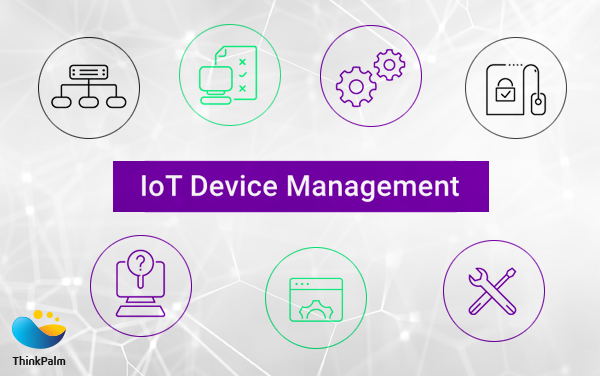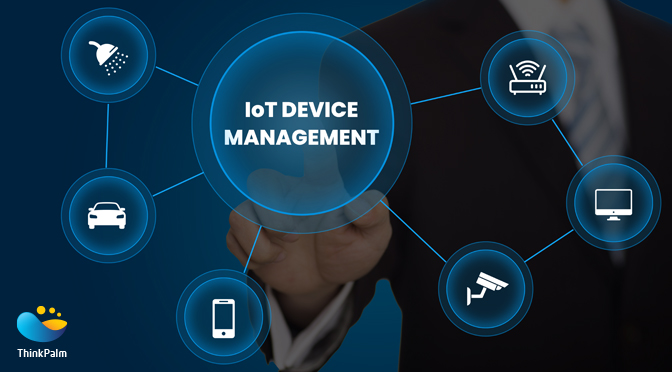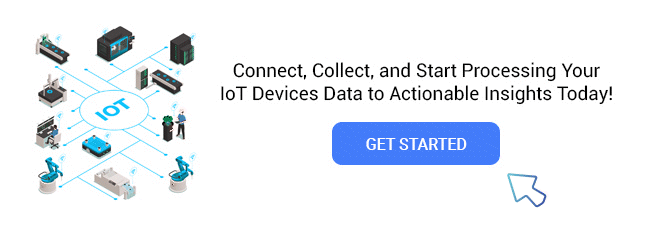IoT device management refers to the process of overseeing and controlling Internet of Things (IoT) devices throughout their lifecycle. Today, let’s explore the realm of IoT device management, the tools, and the tech that help you set up, monitor, and manage your growing collection of connected devices at home or work.
In addition, this article also aims to give you an overview of IoT device management and its key features. On top of all, let’s learn more about the best software solutions available on the market for IoT device management.
What Exactly is IoT Device Management?

Simply put, IoT device management is all about handling connected devices from a central platform that IT administrators can access remotely from anywhere on any device with an internet connection. It includes tasks like setup, maintenance, and monitoring. Tools from major cloud providers like AWS, Google Cloud, and Microsoft Azure offer organizations better control over their mobile devices through IoT device management.
How does IoT Device Management Work?
IoT device management operates by installing a software agent on a device that uses a standard messaging protocol, like MQTT, to talk to the management platform. This process gives control over the entire lifecycle of IoT devices.

Here’s how the IoT device management process works:
- Registering devices: Before your devices start sharing data, you need to sign them up with a management platform.
- Provisioning: Think of this as setting up your devices to work smoothly with your network.
- Authentication: It’s like making sure only the right devices are allowed in, keeping your data safe.
- Configuration: Personalize your devices by tweaking settings or adding extra features.
- Maintenance: Just like updating your phone, IoT devices get regular updates to stay secure and up-to-date.
- Diagnostics: Keep an eye on (monitor) your devices to detect any issues early on and fix them before they become serious issues.
- End of life: When devices are no longer needed, IoT device management makes sure they’re retired securely, and you can keep data for replacement or archive it if needed.
What Are The Key Features Of Iot Device Management?
The key features of IoT device management include:
- Easy onboarding: The software should make it simple for IT admins to add new devices, supporting various types like laptops, IoT devices, smartphones, and tablets.
- Troubleshooting remotely: It should allow fixing issues from a distance, reducing manual efforts and solving user problems quickly.
- Metadata management: The platform should let IT admins easily see and handle each device’s details, such as serial number, make, model, and firmware version, for effective inventory management.
- Analytics and reports: Using user-friendly dashboards, the software provides real-time insights into device analytics, allowing the creation of reports for business purposes.
- Log management: IT admins can view and handle the logs generated by each device, aiding in issue identification and tracking device activity.
- Security: The software should include robust security features like access control, encryption, and authentication to prevent data breaches and unauthorized access.
- Over-the-air (OTA) updates: This feature lets IT admins easily and quickly push updates and patches to devices automatically.
What Are The Benefits of IoT Device Management?
Here are a few significant benefits of IoT device management:
- Easy Updates: This makes updating devices quick and simple for IT admins. They can remotely update many devices at once, saving time and ensuring smooth communication.
- Strong Security: Keeps sensitive data safe by using encryption and segmentation. Admins can control access and updates, maintaining a secure environment.
- Adaptable to Change: Helps businesses quickly adjust to new models. This means better products, understanding customer needs, and finding new ways to make money.
- Quick Device Setup: Speeds up the process of creating, configuring, and deploying connected devices, allowing companies to start using networks faster.
- Better Device Organization: Lets companies organize devices into groups with specific rules. This makes it easier to track devices and follow security and business practices.
- Manage Devices Remotely: Makes it easy to handle devices in the field. Admins can update, reboot, and troubleshoot devices from a distance, ensuring everything runs smoothly.
What Are The Major Drawbacks of IoT Device Management?
Major drawbacks of IoT device management include:
Access Control
- Security is a major concern with IoT devices, which are often left unsecured and unprotected.
- Lack of password protection makes these devices easy targets for cybercriminals.
- IoT device management helps identify, track, and control connected devices.
- Strong access controls and password practices are essential for protecting corporate and customer data.
Device Proliferation
- Managing a large number of IoT devices can strain networks, leading to bandwidth issues, congestion, and outages.
- IoT device management software automates and centrally manages device operations to address network challenges.
Fragmented Data
- The increasing volume and variety of data generated by IoT devices can be challenging to manage.
- IoT device management tools assist in collecting, organizing, and analyzing the often unstructured data.
What Are The Popular Use Cases Of IoT Device Management?
There are several IoT device management use cases, which include the following:
- Smart Homes: People use IoT device management to control and check smart home gadgets like cameras and thermostats from one spot. It also helps fix problems remotely.
- Industries: Companies use IoT device management to handle industrial devices, improving how things work and reducing downtime.
- Healthcare: IoT device management keeps an eye on medical devices and helps healthcare providers monitor patients and track medications.
- Smart Cities: City officials use IoT device management to watch over things like streetlights and traffic systems, making operations smoother and saving money.
- Connected Heating Systems: In buildings, IoT device management lets people control heating systems from their phones or tablets.

What Are The Popular IoT Device Management Software?
Here are some of the most popular IoT device management platforms:
1. AWS IoT Device Management
- Helps organizations remotely onboard, organize, monitor, and manage IoT devices.
- Offers a suite of AWS IoT services covering device software, control services, and analytics.
2. Azure IoT Hub
- Hosted on the Microsoft Azure cloud platform.
- Provides features for device security, provisioning, and device management.
- Includes additional services to assist developers in building IoT applications.
3. Google Cloud IoT Core
- Assists organizations in connecting, managing, and ingesting data from distributed endpoints.
- Fully managed service, eliminating the need for on-site technical expertise.
4. Hologram
- Designed for organizations with a globally distributed IoT presence.
- Simplifies the establishment and management of network connections, especially in areas with multiple local carriers.
- Offers a cellular platform with SIM cards that automatically switch networks, providing IoT devices with coverage across more than 550 carriers in over 200 countries.
Frequently Asked Questions
What is device management in IoT?
IoT device management encompasses the end-to-end lifecycle supervision of IoT devices, including planning, onboarding, monitoring, maintenance, and retirement processes.
What is device control in IoT?
Device control serves as the backbone of any IoT ecosystem, as without it, connected devices remain isolated islands of data. In the rapidly expanding IoT landscape, the significance of efficient and secure IoT device control has never been more crucial.
Why is device management important in IoT?
IoT Device Management is crucial because an internet or cloud-connected devices face the risk of unauthorized access by malicious actors if proper security measures are not implemented.
Conclusion
With the increasing number of devices having internet capabilities, the need for IoT device management software is growing. According to the Cisco Annual Internet Report (2018–2023), there will be 29.3 billion connected devices by 2023 – that’s about 3.6 devices per person globally.
For businesses, managing a multitude of IoT devices is a big deal. They need to ensure these devices are secure, plan for things like updates and user authentication, and handle potential risks. Without proper IoT device management, using devices like smart cars for work-related tasks can pose significant security challenges.
Moreover, there are also incredible opportunities to be unlocked if IoT device management is done correctly. The ongoing data generated by your array of devices can be utilized to readjust products and services, enhancing their adoption. Let ThinkPalm’s customized IoT services and solutions show you the way towards success with our dedicated IIoT platform, NetvirE, for seamless device/asset management, monitoring, and predictive maintenance capabilities to make informed decisions and help your business leap towards success.

Author Bio
Vishnu Narayan is a dedicated content writer and a skilled copywriter working at ThinkPalm Technologies. More than a passionate writer, he is a tech enthusiast and an avid reader who seamlessly blends creativity with technical expertise. A wanderer at heart, he tries to roam the world with a heart that longs to watch more sunsets than Netflix!
